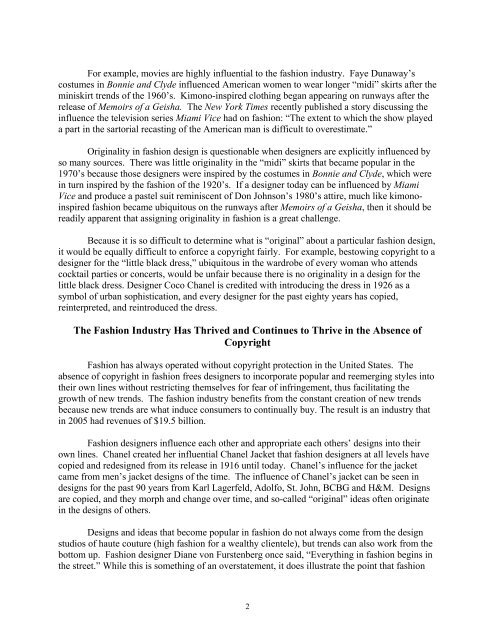Testimony of David Wolfe, Creative Director The ... - Public Knowledge
Testimony of David Wolfe, Creative Director The ... - Public Knowledge
Testimony of David Wolfe, Creative Director The ... - Public Knowledge
Create successful ePaper yourself
Turn your PDF publications into a flip-book with our unique Google optimized e-Paper software.
For example, movies are highly influential to the fashion industry. Faye Dunaway’s<br />
costumes in Bonnie and Clyde influenced American women to wear longer “midi” skirts after the<br />
miniskirt trends <strong>of</strong> the 1960’s. Kimono-inspired clothing began appearing on runways after the<br />
release <strong>of</strong> Memoirs <strong>of</strong> a Geisha. <strong>The</strong> New York Times recently published a story discussing the<br />
influence the television series Miami Vice had on fashion: “<strong>The</strong> extent to which the show played<br />
a part in the sartorial recasting <strong>of</strong> the American man is difficult to overestimate.”<br />
Originality in fashion design is questionable when designers are explicitly influenced by<br />
so many sources. <strong>The</strong>re was little originality in the “midi” skirts that became popular in the<br />
1970’s because those designers were inspired by the costumes in Bonnie and Clyde, which were<br />
in turn inspired by the fashion <strong>of</strong> the 1920’s. If a designer today can be influenced by Miami<br />
Vice and produce a pastel suit reminiscent <strong>of</strong> Don Johnson’s 1980’s attire, much like kimonoinspired<br />
fashion became ubiquitous on the runways after Memoirs <strong>of</strong> a Geisha, then it should be<br />
readily apparent that assigning originality in fashion is a great challenge.<br />
Because it is so difficult to determine what is “original” about a particular fashion design,<br />
it would be equally difficult to enforce a copyright fairly. For example, bestowing copyright to a<br />
designer for the “little black dress,” ubiquitous in the wardrobe <strong>of</strong> every woman who attends<br />
cocktail parties or concerts, would be unfair because there is no originality in a design for the<br />
little black dress. Designer Coco Chanel is credited with introducing the dress in 1926 as a<br />
symbol <strong>of</strong> urban sophistication, and every designer for the past eighty years has copied,<br />
reinterpreted, and reintroduced the dress.<br />
<strong>The</strong> Fashion Industry Has Thrived and Continues to Thrive in the Absence <strong>of</strong><br />
Copyright<br />
Fashion has always operated without copyright protection in the United States. <strong>The</strong><br />
absence <strong>of</strong> copyright in fashion frees designers to incorporate popular and reemerging styles into<br />
their own lines without restricting themselves for fear <strong>of</strong> infringement, thus facilitating the<br />
growth <strong>of</strong> new trends. <strong>The</strong> fashion industry benefits from the constant creation <strong>of</strong> new trends<br />
because new trends are what induce consumers to continually buy. <strong>The</strong> result is an industry that<br />
in 2005 had revenues <strong>of</strong> $19.5 billion.<br />
Fashion designers influence each other and appropriate each others’ designs into their<br />
own lines. Chanel created her influential Chanel Jacket that fashion designers at all levels have<br />
copied and redesigned from its release in 1916 until today. Chanel’s influence for the jacket<br />
came from men’s jacket designs <strong>of</strong> the time. <strong>The</strong> influence <strong>of</strong> Chanel’s jacket can be seen in<br />
designs for the past 90 years from Karl Lagerfeld, Adolfo, St. John, BCBG and H&M. Designs<br />
are copied, and they morph and change over time, and so-called “original” ideas <strong>of</strong>ten originate<br />
in the designs <strong>of</strong> others.<br />
Designs and ideas that become popular in fashion do not always come from the design<br />
studios <strong>of</strong> haute couture (high fashion for a wealthy clientele), but trends can also work from the<br />
bottom up. Fashion designer Diane von Furstenberg once said, “Everything in fashion begins in<br />
the street.” While this is something <strong>of</strong> an overstatement, it does illustrate the point that fashion<br />
2





